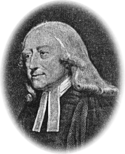- Methodist New Connexion
-
Part of a series on
Methodism
John Wesley Background Doctrines Key people - John Wesley
- Richard Allen
- Francis Asbury
- Thomas Coke
- William Law
- William Williams Pantycelyn
- Howell Harris
- Albert Outler
- James Varick
- Charles Wesley
- George Whitefield
- Countess of Huntingdon
- Bishops · Theologians
Largest groups Related groups Other topics - Connexionalism
- Saints in Methodism
- Homosexuality and Methodism
Methodism portal Methodist New Connexion was a Protestant nonconformist church, also known as the Kilhamite Methodists. It was formed in 1797 by secession from the Wesleyan Methodists, and merged in 1907 with the Bible Christian Church and the United Methodist Free Churches to form the United Methodist Church.
Contents
History
The secession was led by Alexander Kilham, and resulted from a dispute regarding the position and rights of the laity. In 1791, Kilham denounced the Methodist conference for giving too much power to the ministers of the church, at the expense of the laity. The Plan of Pacification adopted by the conference in 1795 further entrenched his position, and Kilham was expelled from the conference in 1797.
Kilham formed the New Connexion, based around his church in Sheffield. It thrived, and soon spread across Britain. At its conferences, ministers and laymen were of equal number, the laymen being chosen by the circuits and in some cases by guardian representatives elected for life by conference. Otherwise the doctrines and order of the Connexion were the same as those of the Wesleyans, although some Wesleyans accused Kilham of revolutionary sympathies and links with Tom Paine.
At the time of the union in 1907, the Methodist New Connexion had some 250 ministers and 45,000 members.
The Methodist New Connexion missionary work in China
The Methodist New Connexion entered China in 1860, immediately after the close of the second opium war, and after the signing of the Treaty of Tianjin, which virtually opened all China to the Christian missionary. The pioneers of the movement were Revs. John Innocent and W. N. Hall, who established themselves in Tianjin, which was then a pioneer mission field. Mr. Hall died of fever in 1878, but Mr. Innocent survived, and was the Nestor of the Mission. There were three preaching rooms in the city of Tianjin, one being in the main thoroughfare, and in these daily preaching was kept up. On the English concession there was a large mission establishment, consisting of a training college for native students for the ministry, missionaries houses, and a boarding school for the training of native women and girls in Christian life and work. Rev. J. Robinson-Brown was the principal of the college, and Miss Waller was in charge of the girls school.
The largest mission of this Society was in the north-east portion of the province of Shandong, where about fifty native churches were maintained in an agricultural district extending over about three hundred miles. The headquarters of this circuit were in Chu Chia, Lao-ling district, where were situated the mission houses, and a medical dispensary and hospital. Mr. Innocent was the head of this circuit, and the hospital was in charge of Drs. W. W. Shrubshall and F. W. Marshall. In this place also is located Rev. J. K. Robson, who had devoted himself to the work of the Mission at his own charges.
Another mission was opened at the Tang-san Collieries, near Kai Ping, in the north of the province of Chih-li. This is under the charge of Rev. F. B. Turner, and rapidly extended, having a church in the ancient city of Yung-ping-fu, near the old wall, and also several rural chapels in the district round Kai Ping.
The work of this Society was chiefly carried on by native agency; a large number of efficient men had been trained and qualified by means of the training college. Several native women were also set apart as Biblewomen to their own sex ; one of these, Mrs. Hu, had labored in this capacity for nearly twenty-five years, and was the first such agent ever employed in China. This Mission in 1890 numbered seven missionaries, two medical agents, one lady agent, forty-six native helpers, and six female native helpers. It had over thirteen hundred communicants, and about two hundred and fifty scholars in its day and boarding schools. [1]
References
- Townsend, William (1890). Robert Morrison : the pioneer of Chinese missions. London: S.W. Partridge.
- The Penguin Dictionary of British History, Ed. Juliet Gardiner
 This article incorporates text from a publication now in the public domain: Chisholm, Hugh, ed (1911). Encyclopædia Britannica (11th ed.). Cambridge University Press.
This article incorporates text from a publication now in the public domain: Chisholm, Hugh, ed (1911). Encyclopædia Britannica (11th ed.). Cambridge University Press.Notes
- ^ Townsend (1890), 246-247
See also
- Protestant missionary societies in China during the 19th Century
Categories:- Christian missions in China
- Methodist denominations
- Christianity in Sheffield
- Religious organizations established in 1797
- 1907 disestablishments
- Methodist organizations established in the 18th century
- Former Methodist denominations
Wikimedia Foundation. 2010.
